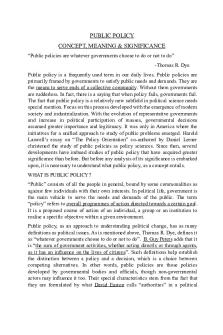Determination and Clinical significance of BUN and Creatinine PDF

| Title | Determination and Clinical significance of BUN and Creatinine |
|---|---|
| Author | Hey Yow |
| Course | Clinical Chemistry 1 |
| Institution | Our Lady of Fatima University |
| Pages | 4 |
| File Size | 63.1 KB |
| File Type | |
| Total Downloads | 16 |
| Total Views | 147 |
Summary
Determination and Clinical significance of BUN and Creatinine...
Description
NON-PROTEIN NITROGEN Urea major excretory product of protein metabolism formed in the liver from amino groups (-NH2) and free ammonia generated during protein catabolism concentration of urea in the plasma is determined by renal function and perfusion, the protein content of the diet, and the rate of protein catabolism Blood Urea Nitrogen In severe liver damage, levels of urea decreases. It is also the first metabolite to increase in kidney disease, It is used as a screening test for kidney disease. Urea is readily removed by dialysis. 90% Urea is excreted; 10% remain in the blood Major organic solid in the urine Clinical Application evaluate renal function, to assess hydration status, to determine nitrogen balance, to aid in the diagnosis of renal disease, and to verify adequacy of dialysis Micro-Kjeldahl Nessler Oldest method N àNH4 + alk. K2HgI4 àNH2HgI3
Double iodide of K and Hg
Dimercuric ammonium iodide
Kjeldahl process
Mixture of sulfuric acid and phosphoric acid
Urea nitrogen concentration can be converted to urea concentration by multiplying by 2.14 Urea nitrogen concentration expressed in milligrams per deciliter may be converted to urea concentration in millimoles per liter by multiplying by 0.357
Blood Urea Nitrogen Determination Urea is hydrolyzed to ammonium carbonate by urease and ammonia reacts with phenol and sodium hypochlorite in an alkaline medium forming a blue indophenol. ENZYMATIC AND ACID TITRATION
Urea is hydrolyzed by urease forming ammonia which is then titrated with a weak acid. -
Van Slyke Cullen
-
Urograph
DIRECT MEASUREMENT OF UREA
Diacetyl Monoxime Method (DAM) ▪
Urea is made to react with diacetyl monoxime to produce a yellow diaxine derivative (Fearon's reaction).
▪
Arsenic thiosemicarbazide is added to enhance color formation and to exclude protein interference.
Consideration in BUN Determination The determination is affected by high protein diet, hydration and other physiologic functions. Whole blood should be deproteinized to eliminate interferences of hemoglobin. Ammonium-containing anticoagulants are contraindicated in enzymatic methods. Sodium fluoride inhibits the action of urease. Upon prolonged standing, ammonia concentration in the sample rises 2-3 times the original value due to enzymatic deamination of labile amide like glutamine. NORMAL VALUE: 7-18 mg/dL (2.5 - 6.4 mmol/L) CONVERSION FACTOR: 0.357 Clinical Significance Pre-renal causes - conditions in which circulation through the kidneys is less efficient than usual.
Hemorrhage (blood loss)
Cardiac decompression
Increased protein catabolism
Heatstroke (Dehydration)
Burns (Fluid loss)
Renal causes - characterized by the presence of lesions on the parenchyma itself (tubular injury).
Chronic nephritis
Acute glomerulonephritis (AGN)
Polycystic kidney
Nephroschlerosis
Tubular necrosis
Post-renal causes - due to the obstruction in the-urinary-tract due to:
Stones
Prostatic enlargement
Tumor
AZOTEMIA - ("azo”) - nitrogen containing a- biochemical abnormality that refers to an increase in BUN and creatinine levels which is largely related to decrease glomerular filtration. UREMIA - defined as the increased in urea and creatinine (azotemia) with accompanying clinical signs and symptoms of renal failure like:
Metabolic acidosis due to failure of the kidneys to eliminate acidic products of metabolism
Hyperkalemia due to failure of potassium excretion
Generalized edema due to water retention
Creatinine Creatinine is the principal waste product of muscular metabolism derived mainly from creatine (alpha-methyl guanidoacetic acid) It is synthesized form three amino acids (methionine, arginine and lysine) Creatinine Determination Creatinase Method
Available on Ektachem analyzer wherein creatinine is hydrolyzed to N-methyldantolin and ammonia by creatinase. The ammonia is then made to react with alphaketoglutarate and NADH in the presence of glutamate dehydrogenase forming glutamate and NAD. The decrease in NADH is followed fluorometrically.
Creatinine Aminohydrolase Method
Creatinine is hydrolyzed'to creatine by,creatinine aminohydrolase followed by a series of coupled enzyme reactions in which creatine reacts with creatinine kinase, pyruvate kinase, and !actate dehydrogebase, culminating in the oxidation of the NADH.
Direct Jaffe Reaction Methods It is the formation of red tautomer of creatinine picrate when creatinine in serum is made to react with a freshly prepared alkaline sodium picrate solution (alkaline picrate - Jaffe reagent). NORMAL VALUE: 0.6 - 1.2 mg/dL (53-106 umol/L) CONVERSION FACTOR: 88.4 Clinical significance Aside from renal diseases, it is also elevated in myopathies like:
Muscular dystrophies
Familial periodic paralysis
Myasthenia gravis
Dermatomyositis
Creatine Synthesized from amino acid arginine, methionine, and glycine. It is increased in muscular dystrophies....
Similar Free PDFs

Design-Utility and Significance
- 13 Pages

Significance Of Research
- 1 Pages
Popular Institutions
- Tinajero National High School - Annex
- Politeknik Caltex Riau
- Yokohama City University
- SGT University
- University of Al-Qadisiyah
- Divine Word College of Vigan
- Techniek College Rotterdam
- Universidade de Santiago
- Universiti Teknologi MARA Cawangan Johor Kampus Pasir Gudang
- Poltekkes Kemenkes Yogyakarta
- Baguio City National High School
- Colegio san marcos
- preparatoria uno
- Centro de Bachillerato Tecnológico Industrial y de Servicios No. 107
- Dalian Maritime University
- Quang Trung Secondary School
- Colegio Tecnológico en Informática
- Corporación Regional de Educación Superior
- Grupo CEDVA
- Dar Al Uloom University
- Centro de Estudios Preuniversitarios de la Universidad Nacional de Ingeniería
- 上智大学
- Aakash International School, Nuna Majara
- San Felipe Neri Catholic School
- Kang Chiao International School - New Taipei City
- Misamis Occidental National High School
- Institución Educativa Escuela Normal Juan Ladrilleros
- Kolehiyo ng Pantukan
- Batanes State College
- Instituto Continental
- Sekolah Menengah Kejuruan Kesehatan Kaltara (Tarakan)
- Colegio de La Inmaculada Concepcion - Cebu













